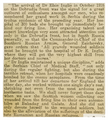File:Newspaper cutting from "The Scotsman" - 1916.png
Newspaper_cutting_from_"The_Scotsman"_-_1916.png (359 × 400 pixels, file size: 277 KB, MIME type: image/png)
This is a file from the Wikimedia Commons. The description on its description page there is copied below.
Summary
| DescriptionNewspaper cutting from "The Scotsman" - 1916.png |
English: Newspaper cutting from "The Scotsman", 1916.
This image is taken from Ethel Moir Diary.
Item number: 26530. You can view this image in its original context on the Capital Collection catalogue When war broke out in August 1914, the people of Britain responded. Men volunteered for the army and others set about establishing relief units to help the army or provide assistance to civilians and refugees. The Scottish Women's Hospitals were one of those - yet they were also very different, because they were set up with two specific aims: to help the war effort by providing medical assistance, and to promote the cause of women's rights and by their involvement in the war, help win those rights. The SWH's original idea was set up a hospital in Edinburgh to help treat the war wounded. However this was soon abandoned in favour of setting up hospitals in the field, close to the fighting. Fundraising commenced and by the end of August 1914, more than five thousand pounds had been raised. The SWH founder Dr Elsie Inglis approached the War Office with the idea of medical units being allowed to serve on the Western Front. The offer was turned down and she was told by an official "My good lady, go home and sit still". Undeterred, Scottish Women's Hospitals opened its first 200 bed Auxiliary hospital at the 13th Century Abbaye de Royaumont in France. The Scottish Women's Hospitals were very closely associated with Serbia and although they operated hospitals in France, Macedonia, Greece, Corsica, Romania and Russia the majority of their work was to help Serbia. Conditions in Serbia were dire; the army had less than 300 doctors to serve more than half a million men. By the winter of 1915 Serbia could hold out no more, and were forced to retreat into Albania. The SWH had a choice to make, stay and go into captivity or go with the retreating army into Albania. Some stayed and several including Elsie Inglis were taken prisoner and later repatriated to Britain. The army retreated over the mountains with no food, shelter or help suffering many casualties. Following her repatriation to Britain in February 1916, Elsie Inglis set about equipping and staffing a hospital to serve in Russia. It served in southern Russia and in Romania, providing medical help to the Serbian Division of the Russian Army. This division was made up from Serbs and Yugoslavs who had been taken prisoner by the Russians but had volunteered to fight for the allies. The SWH once again had to retreat. The hospital was withdrawn and they sailed back from Archangel to the UK. The day after they returned back, Elsie Inglis who had been ill for some time, died. Towards the end of the war the SWH in Serbia provided medical care to soldiers, civilians and prisoners of war. A new fixed hospital was established in Vranje and by early 1919 this was handed over to the Serbian authorities bringing to an end the SWH. Most SWH members returned home and resumed their pre war lives, others stayed behind to continue to provide medical care in Serbia. Over 1,000 women from many different backgrounds and many different countries served with the SWH. Only medical professionals such as doctors, nurses, laboratory technicians and X ray operators received a salary, all others received no pay at all and were expected to pay their own way. Some women joined because it was one of the few opportunities open to women to actively help the war effort, for others it was the rare chance for adventure. |
||
| Date | |||
| Source |
|
||
| Author | The Scotsman |
Licensing
| Public domainPublic domainfalsefalse |
This file is in the public domain because UK Copyright, Design and Patents Act 1988, s12(3)(b) and Sch I s15(1)
|
Captions
Items portrayed in this file
depicts
1916
File history
Click on a date/time to view the file as it appeared at that time.
| Date/Time | Thumbnail | Dimensions | User | Comment | |
|---|---|---|---|---|---|
| current | 00:43, 26 July 2017 |  | 359 × 400 (277 KB) | Stinglehammer | User created page with UploadWizard |
File usage
The following page uses this file:
Global file usage
The following other wikis use this file:
- Usage on en.wikipedia.org
- Usage on it.wikipedia.org
Metadata
This file contains additional information, probably added from the digital camera or scanner used to create or digitize it.
If the file has been modified from its original state, some details may not fully reflect the modified file.
| PNG file comment |
|
|---|---|
| Horizontal resolution | 118.11 dpc |
| Vertical resolution | 118.11 dpc |
